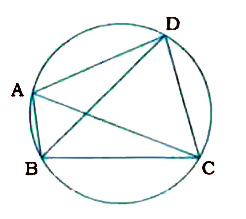ABCD is a quadrlateral in which BD and AC are diagonals then
AB+BC+CD+AD<AC+BD
AB+BC+CD+DA>AC+BD
AB+BC+CD+DA=AC+BD
AB+BC+CD+DA>2(AC+BD)
The correct Answer is:B
Step by step video & text solution for ABCD is a quadrlateral in which BD and AC are diagonals then by Maths experts to help you in doubts & scoring excellent marks in Class 14 exams.
Updated on:21/07/2023Topper's Solved these Questions
- GEOMETRYBook:KIRAN PUBLICATIONChapter:GEOMETRYExercise:QUESTIONS ASKED IN PREVIOUS SSC EXAMS (TYPE- XI)
Explore 22 Videos
- GEOMETRYBook:KIRAN PUBLICATIONChapter:GEOMETRYExercise:QUESTIONS ASKED IN PREVIOUS SSC EXAMS (TYPE- XII)
Explore 90 Videos
- GEOMETRYBook:KIRAN PUBLICATIONChapter:GEOMETRYExercise:QUESTIONS ASKED IN PREVIOUS SSC EXAMS (TYPE-IX)
Explore 5 Videos
- DISCOUNTBook:KIRAN PUBLICATIONChapter:DISCOUNTExercise:Test Yourself
Explore 10 Videos
- LCM AND HCF Book:KIRAN PUBLICATIONChapter:LCM AND HCF Exercise:Test Yourself
Explore 18 Videos
Similar Questions
Knowledge Check
ABCD is a parallelogram with AC and BD as diagonals. Then, A→C−B→D=
A4A→BB3A→BC2A→BDA→BABCD is a quadrilateral. AM and CN are perpendiculars to BD, AM= CN and diagonals AC and BD intersect at O, then which one of the following is correct?
AAO=OCBBO=ODCAO=BODCO=DOABCD is a quadrilateral whose diagonals are AC and BD. Which one of the following is correct?
A−−→BA+−−→CD=−−→AC+−−→DBB−−→BA+−−→CD=−−→BD+−−→CAC−−→BA+−−→CD=−−→AC+−−→BDD−−→BA+−−→CD=−−→BC+−−→AD
In the given figure ABCD is a cyclic quadrilateral in which AC and BD are its diagonals. If ∠DBC=55∘and∠BAC=45∘, find ∠BCD.

View SolutionABCD is a cyclic quadrilateral of which AB is the diameter. Diagonals AC and BD intersect at E. If ∠DBC=35∘, Then ∠AED measures
View SolutionIf ABCD is a quadrilateral whose diagonals AC and BD intersect at O, then

View SolutionABCD is a parallelogram where AC and BD are the diagonals. If ∠BAD=60∘,∠ABD=90∘, then what is BD2 equal to ?
View SolutionABCD is a quadrilateral whose diagonals are AC and BD. Which one of the following is correct?
View Solution